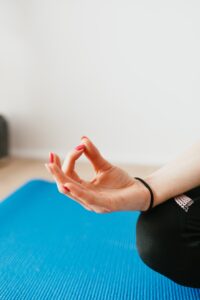Yoga is a physical, mental, and spiritual discipline that originated in ancient India. It is believed to have been developed by the Indus-Sarasvati civilization in Northern India over 5,000 years ago. The word “yoga” comes from the Sanskrit root “yuj,” which means “to join” or “to yoke.” The ultimate goal of yoga is to attain a state of physical and mental balance and to experience a sense of unity with the universe.
 Yoga can be beneficial for people of all ages. It can help improve flexibility, strength, balance, and relaxation in people of all ages. Many people find that they can start practising yoga at any age and that they can continue to practice it throughout their lives. Some yoga poses and techniques may be more appropriate for certain age groups, and it is always a good idea to consult with a qualified instructor if you have any concerns about your ability to practice yoga. Additionally, it is important to listen to your body and not push yourself too hard, especially if you are just starting out.
Yoga can be beneficial for people of all ages. It can help improve flexibility, strength, balance, and relaxation in people of all ages. Many people find that they can start practising yoga at any age and that they can continue to practice it throughout their lives. Some yoga poses and techniques may be more appropriate for certain age groups, and it is always a good idea to consult with a qualified instructor if you have any concerns about your ability to practice yoga. Additionally, it is important to listen to your body and not push yourself too hard, especially if you are just starting out.
Yoga is practised all over the world today. It has become a popular form of exercise and stress management in many countries, and there are yoga studios, classes, and retreats available in many cities and towns. Yoga is also often practised in homes, parks, and other community spaces. In addition to physical yoga practices, yoga philosophy and mindfulness techniques are also taught and practised in various settings such as schools, hospitals, and corporations.
Yes, yoga can benefit both physical abilities and mental well-being. Regular yoga practice can improve flexibility, strength, balance, and muscle tone. It can also help reduce stress and improve relaxation, concentration, and sleep. Many people find that a regular yoga practice helps them feel more calm, centred, and present in their daily lives. Some research has also suggested that yoga may have other health benefits, such as reducing inflammation and improving cardiovascular health. However, it is always a good idea to consult with a healthcare provider before starting any new exercise program, especially if you have any medical conditions or injuries.
Yes, there are many different types of yoga, and they can vary in terms of the techniques, postures, and philosophies they incorporate. Here are a few examples:
- Hatha yoga: This is a general term that refers to any type of yoga that involves physical postures and breathing techniques. Hatha yoga classes are often slow-paced and gentle, and they can be a good option for beginners.
- Vinyasa yoga: Vinyasa yoga, also known as “flow” yoga, involves a series of poses that are linked together in a sequence and performed in synchronization with the breath. Vinyasa classes tend to be more active and dynamic than Hatha classes.
- Ashtanga yoga: Ashtanga yoga is a rigorous and physically demanding form of yoga that involves performing a set series of postures in a specific order. Ashtanga classes are typically fast-paced and involve a lot of movement.
- Bikram yoga: Bikram yoga, also known as “hot” yoga, is practised in a heated room to increase flexibility and sweat out toxins.
- Yin yoga: Yin yoga involves holding passive, seated poses for extended periods of time in order to stretch the connective tissues in the body. Yin yoga classes are often slower-paced and more meditative.
There are many other types of yoga as well, and the best type for you will depend on your goals, physical abilities, and personal preferences. Some people enjoy trying different types of yoga to see which ones they like best, while others prefer to stick with one specific type of practice.
the best type for you will depend on your goals, physical abilities, and personal preferences. Some people enjoy trying different types of yoga to see which ones they like best, while others prefer to stick with one specific type of practice.
A good yoga practice is one that is safe, enjoyable, and meets your personal goals and needs. Here are a few tips for starting and maintaining a good yoga practice:
- Find an instructor you feel comfortable with: Look for an instructor who is qualified, experienced, and teaches in a style that you enjoy.
- Start slowly: If you are new to yoga, it’s important to start slowly and not try to do too much too soon. Gradually build up your practice as you become more comfortable and confident.
- Listen to your body: Yoga should not be painful. If you feel discomfort or pain while practising, try backing off or modifying the pose.
- Be consistent: It’s important to practice regularly in order to see progress and benefits. Aim to practice a few times per week, and try to make it a part of your daily routine.
- Stay open-minded: Yoga is a journey, and your practice will evolve and change over time. Try to stay open-minded and be willing to try new things.
- Have fun: Remember to relax and have fun with your practice. Yoga is not about perfection, it’s about self-discovery and growth.
 In the United Kingdom, there are several organizations that regulate and promote the practice of yoga. One of the main organizations is the British Wheel of Yoga (BWY), which was founded in 1965 and is the national governing body for yoga in the UK. The BWY sets standards for yoga teacher training and continuing professional development, and it works to promote the benefits of yoga to the public. The BWY also offers insurance for yoga teachers and students, and it runs events and workshops for yoga practitioners. Other organizations that promote yoga in the UK include the Yoga Alliance UK and the Independent Yoga Network.
In the United Kingdom, there are several organizations that regulate and promote the practice of yoga. One of the main organizations is the British Wheel of Yoga (BWY), which was founded in 1965 and is the national governing body for yoga in the UK. The BWY sets standards for yoga teacher training and continuing professional development, and it works to promote the benefits of yoga to the public. The BWY also offers insurance for yoga teachers and students, and it runs events and workshops for yoga practitioners. Other organizations that promote yoga in the UK include the Yoga Alliance UK and the Independent Yoga Network.
Yes, the British Wheel of Yoga (BWY) has affiliated schools and organizations throughout England and the rest of the UK. These affiliated centres offer yoga classes, teacher training programs, and other yoga-related events and activities. The BWY also has a network of qualified yoga teachers who are trained and accredited by the organization. In addition to the BWY, there are many other schools, studios, and organizations that offer yoga classes and teacher training programs in England and the rest of the UK. Some of these organizations may be affiliated with the BWY or other national or international yoga organizations, while others may be independent.